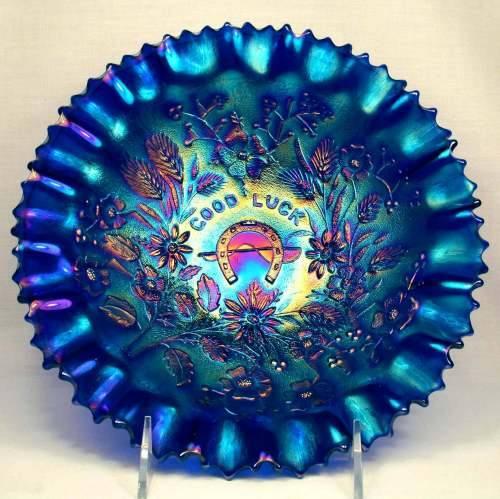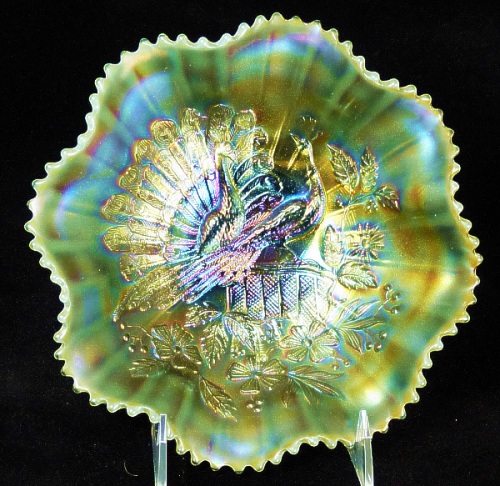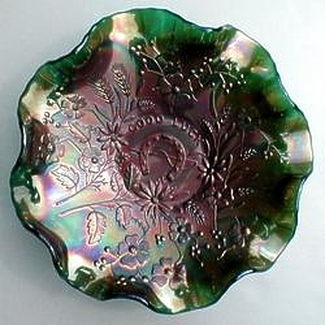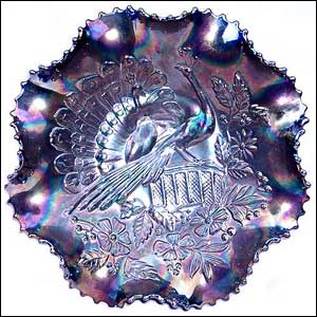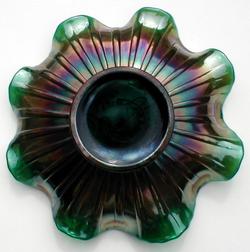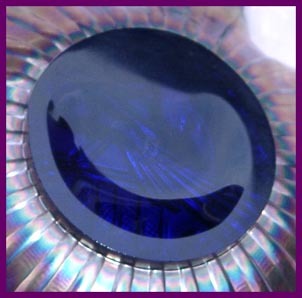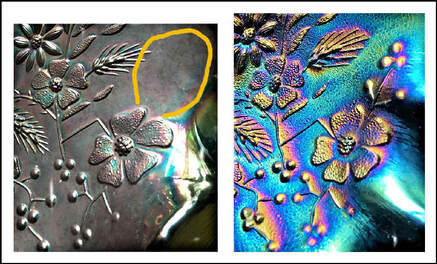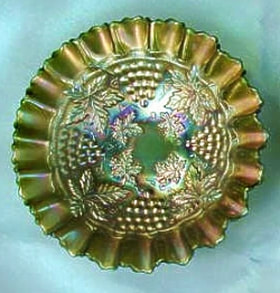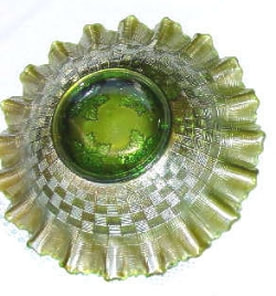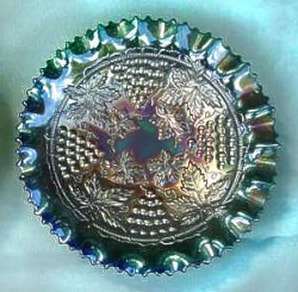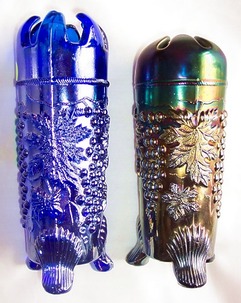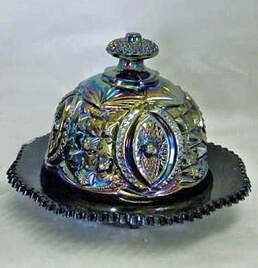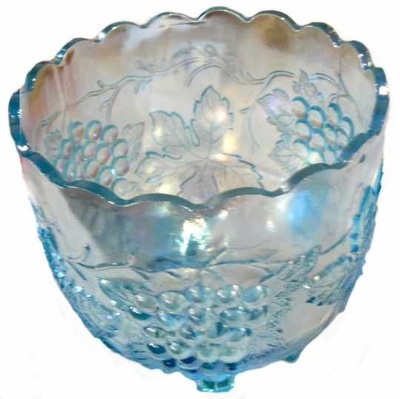Northwood Fakes and how to spot them
All these Northwood Carnival Glass patterns have been faked, but with a bit of knowledge, they are easily spotted.: Good Luck; Peacocks; Grape and Cable bowls and Grape and Cable hatpin holders; Memphis covered butters.
Fake Peacocks and Good Luck bowls
It is likely that the fakes all come from the same unknown source in the Far East. They are pretty good copies of the original patterns and have deceived many a new collector. It was reported as early as the 1980s that a shop in one of the London antique markets had fake Peacocks bowls stacked up dozens high! These early examples were thick and heavy with a dull finish that soon oxidized, but more recent examples are lighter, thinner and brasher looking.
The exterior pattern may be a copy of Northwood's Basketweave or Ribs. Some examples can be spotted as they have iridescence on the base, others have a solid disk of glass where the indented collar base should be. Those with the solid disk could be termed the second generation of fakes and often have an over-shiny iridescence compared to the dull, thick finish on the early examples. A new generation of fakes has also been reported, better than the earlier fakes. Whilst the earlier examples were heavy, the latest ones are lighter, more like the original Northwood items in weight, and a rather poor attempt at a pie-crust finish may be evident.
Fake Peacocks and Good Luck bowls
It is likely that the fakes all come from the same unknown source in the Far East. They are pretty good copies of the original patterns and have deceived many a new collector. It was reported as early as the 1980s that a shop in one of the London antique markets had fake Peacocks bowls stacked up dozens high! These early examples were thick and heavy with a dull finish that soon oxidized, but more recent examples are lighter, thinner and brasher looking.
The exterior pattern may be a copy of Northwood's Basketweave or Ribs. Some examples can be spotted as they have iridescence on the base, others have a solid disk of glass where the indented collar base should be. Those with the solid disk could be termed the second generation of fakes and often have an over-shiny iridescence compared to the dull, thick finish on the early examples. A new generation of fakes has also been reported, better than the earlier fakes. Whilst the earlier examples were heavy, the latest ones are lighter, more like the original Northwood items in weight, and a rather poor attempt at a pie-crust finish may be evident.
|
Shown here on the right is a very useful hint on how to spot the Good Luck fakes. This interesting “tell” was revealed on our Facebook NetworK Group by Mike Brown, who pointed out that there is an element missing on the fakes. Here’s what Mike wrote: “The original fake Good Lucks have the buds missing that emerge from the top of the flower at 4 o'clock position on the bowl. There should be 5 buds here. There are some that have only 3 buds but these seem to be quite rare.” In the pair of photos, we show a fake on the left, with the area of the missing buds circled in yellow, alongside the same section of the genuine Good Luck bowl, with the buds in place. Remember it's at the 4 o'clock position of the pattern. There are other ways of spotting the fakes, of course, but this is a neat way to clinch the matter. Originally reported in NetworK #74 |
Fake Grape and Cable bowls - how to spot them?
- the grapes on the reproduced items are all about the same size whereas on the original pieces the grapes appear to gradually get smaller towards the center of the bowl.
- the pattern seems to fill the space on the face of the bowl proportionately more than on the originals, going further out to the edge than on the original Northwood examples.
- many examples bear a large looking N mark, which is cruder in appearance than the genuine Northwood N. The fake N is neither underlined nor in a circle.
The best advice to new collectors is to study examples you know to be genuine (experienced collectors are usually willing to help) - they are significantly different from the fakes. To an experienced eye, the fake is easy to spot. Colors so far reported for the fake bowls are marigold, blue and green.
Ray and Jean Rogers in Australia have studied their own example of the Grape & Cable fake. Their observations are below - pictures all courtesy of Ray Rodgers.
- the grapes on the reproduced items are all about the same size whereas on the original pieces the grapes appear to gradually get smaller towards the center of the bowl.
- the pattern seems to fill the space on the face of the bowl proportionately more than on the originals, going further out to the edge than on the original Northwood examples.
- many examples bear a large looking N mark, which is cruder in appearance than the genuine Northwood N. The fake N is neither underlined nor in a circle.
The best advice to new collectors is to study examples you know to be genuine (experienced collectors are usually willing to help) - they are significantly different from the fakes. To an experienced eye, the fake is easy to spot. Colors so far reported for the fake bowls are marigold, blue and green.
Ray and Jean Rogers in Australia have studied their own example of the Grape & Cable fake. Their observations are below - pictures all courtesy of Ray Rodgers.
|
Grape and Cable - Original
Back of Grape and Cable - Original
|
Grape and Cable - FAKE
Back of Grape and Cable - FAKE
|
Ray and Jean were responding to the wwwcga Mailing List (see Links) in response to a query from a member about what was thought to be a fake Grape and Cable bowl. Ray's observations on the fake piece were that: - the edge of the fake has two distinct differences: 1. There is a ring just below the bullet edge on the reverse, which you can see on the photo, to obviously make the rim of the bowl thinner. The bullet points are molded to shape whereas the old points are stretched and less clearly defined. 2. The edge fluting on the fake extends in only as far as the first row of the basket weave. The fluting on the old extends three rows of basket weave. - the fake has a ground base and the irridising on the reverse goes right to the bottom of the collar base. On the original bowl the edge of the collar base is not iridised. - the N mark on the fake is much heavier than the old which is enclosed in a circle. |
|
Grape and Cable hatpin holders and butters.
The hatpin holder fakes turn up in several colours, such as the red/amberina and the blue examples shown here. Some years ago, we saw boxes full of these fakes at the back of an "antique" store in the US. When viewed alongside the Northwood original, the fakes are easy to recognise, but on their own they could catch out less experienced collectors. The flutes at the top are the most distinctive feature, in that on the fakes, they stick up noticeably, whereas the originals are curved over. Update January 2021: the fakers have realised that the upright flutes are "give-aways", and newer versions of the fakes have been found with the flutes curved over, in the style of the old original hatpin holders. So, whilst upright flutes are a distinctive sign of the fakes, they are not definitive. Fake Grape and Cable butters were made by Mosser in ice blue and amber in the mid-1970s, and subsequently in cobalt blue. The base of this butter dish has a smooth scalloped edge, unlike the original Northwood which has a sawtooth edge. |
FAKE Red/amberina hatpin folder |
FAKE blue hatpin holder
alongside an original in green |
|
Memphis Fakes In recent years fake Memphis covered butter dishes have turned up regularly - pictured on the right. So far, they always dark purple (sometimes referred to as "black amethyst), with generally bright iridescence. To our knowledge, no authenticated Northwood Memphis butters have been reported, only the fake version. |
More about Fakes - click on the image below.
